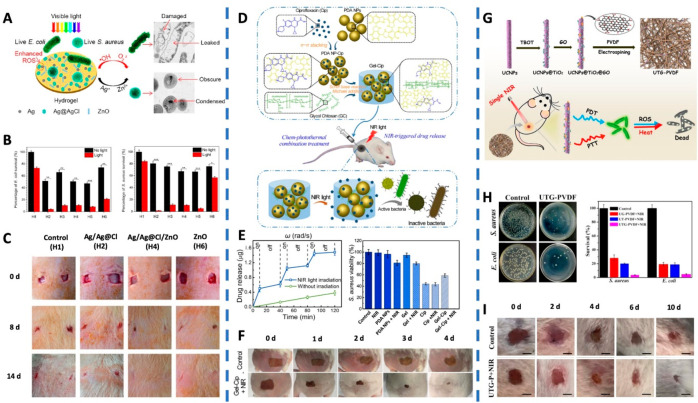Figure 5.
(A) Schematic of the visible light triggered photodynamic therapy for Ag/Ag@Cl/ZnO hydrogel for bacterial inactivation. (B) Ability of the hydrogels in killing E. coli and S. aureus under simulated sunlight. (C) In vivo study on the effects of treatment of S. aureus-induced wound infections by hydrogels and the corresponding wound photographs of the rats at days 0, 8, and 14. (H1, control hydrogel; H2, Ag/Ag@AgCl hydrogel; H3, H4, and H5: Ag/Ag@AgCl/ZnO hydrogels; H6, ZnO hydrogel). Reproduced from Mao et al., 2017.83 Copyright 2017 American Chemical Society. (D) Schematics of the synthetic route of Gel-Cip and NIR light irradiation-triggered Cip release from Gel-Cip for bacterial inactivation. (E) NIR light-triggered Cip release from Gel-Cip. The corresponding statistical diagram of S. aureus colonies with various treatments. (F) Photographs of S. aureus-infected wound of mice after treated with Gel-Cip and NIR light irradiation. Reproduced from Gao et al., 2019.84 Copyright 2018 Elsevier Ltd. (G) Schematic of the synthesis of UTG-PVDF nanocomposite membrane and the bactericidal activities of UTG-PVDF membrane upon NIR Light Illumination. (H) Photographs of S. aureus and E. coli colonies on the UTG-PVDF membrane upon NIR irradiation. Histogram showing the relative bacterial survival. (I) Photographs of wounds on the mice during the therapeutic process. Reproduced from Sun et al., 2019.88 Copyright 2019 American Chemical Society.

